Management 7: Communication and Leadership in Sports Organizations
VerifiedAdded on 2022/09/09
|8
|1473
|17
Report
AI Summary
This report, prepared for a Management 7 course, explores the crucial aspects of communication and leadership within sports and fitness organizations. It begins by differentiating between leadership and management, highlighting their distinct roles and collaborative nature in achieving organizational success. The report then delves into the definitions of moral values and ethics, emphasizing how leaders can foster a shared sense of moral purpose within their organizations, providing relevant examples. Furthermore, it examines the application of both hard and soft leadership approaches in managing people, using practical examples to illustrate their effectiveness. The report concludes with an analysis of the Australian Cricketers' Association, discussing its organizational structure, advantages, and disadvantages. The report utilizes various academic sources to support its claims and provides a comprehensive overview of leadership and management principles in a sports context.
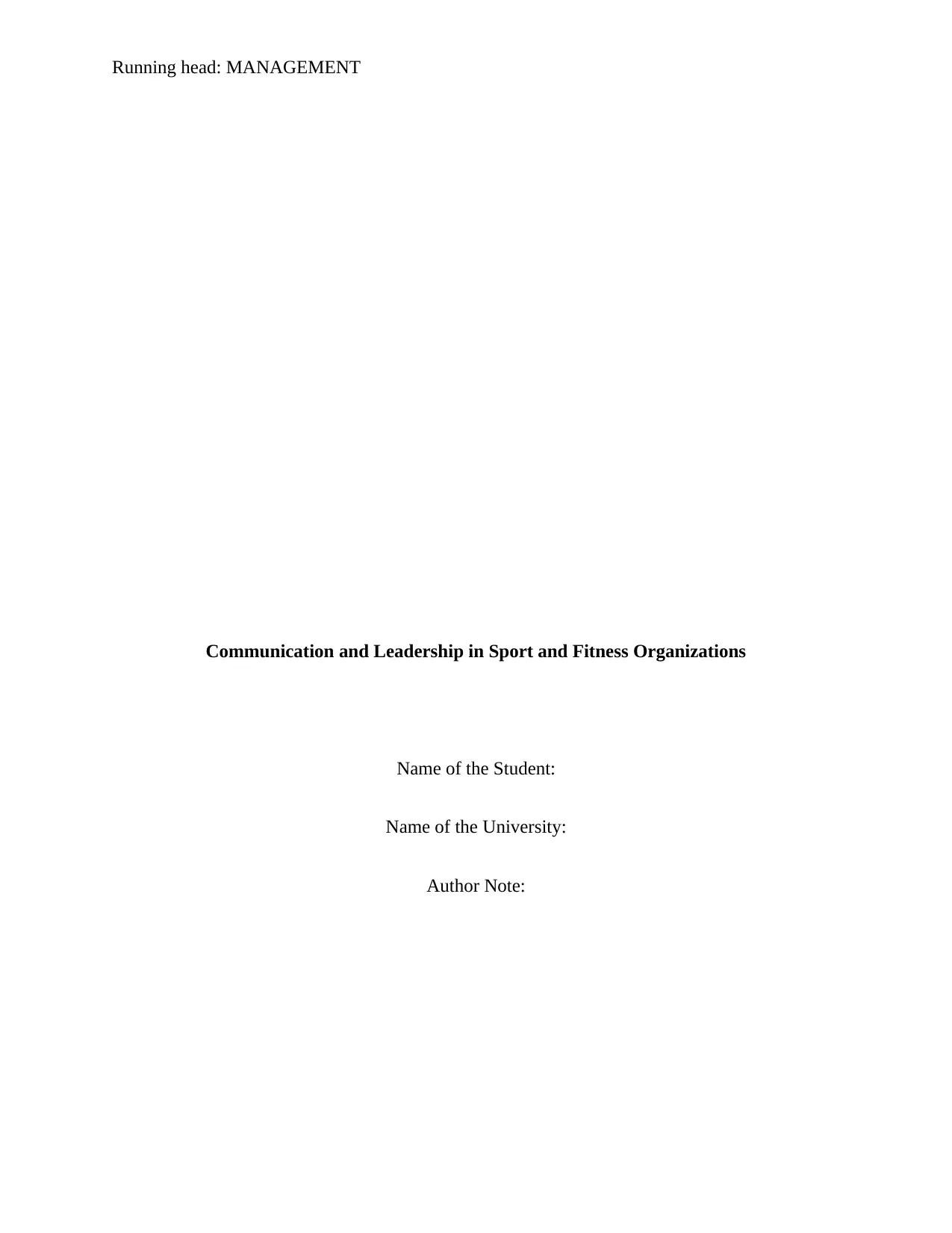
Running head: MANAGEMENT
Communication and Leadership in Sport and Fitness Organizations
Name of the Student:
Name of the University:
Author Note:
Communication and Leadership in Sport and Fitness Organizations
Name of the Student:
Name of the University:
Author Note:
Paraphrase This Document
Need a fresh take? Get an instant paraphrase of this document with our AI Paraphraser
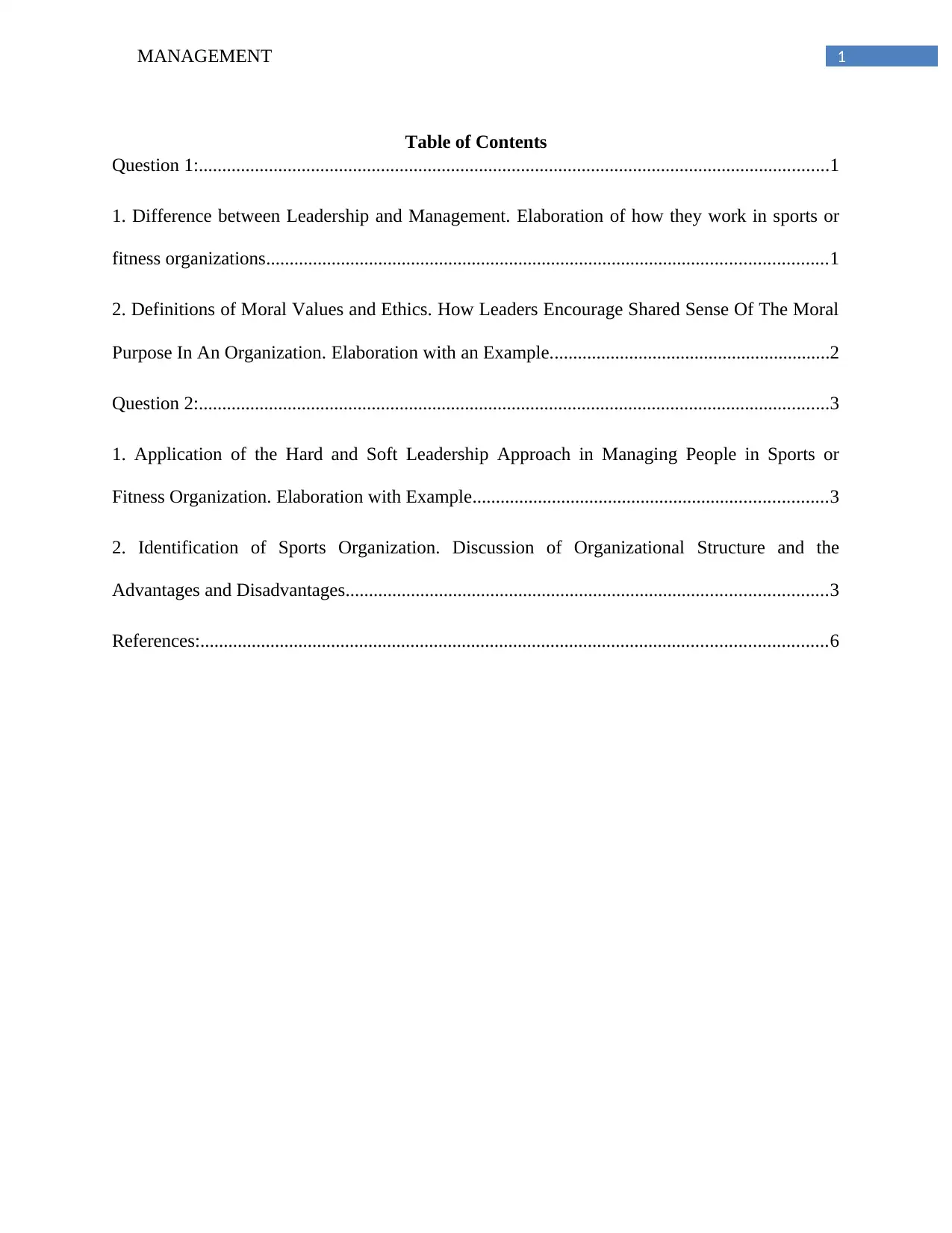
1MANAGEMENT
Table of Contents
Question 1:.......................................................................................................................................1
1. Difference between Leadership and Management. Elaboration of how they work in sports or
fitness organizations........................................................................................................................1
2. Definitions of Moral Values and Ethics. How Leaders Encourage Shared Sense Of The Moral
Purpose In An Organization. Elaboration with an Example............................................................2
Question 2:.......................................................................................................................................3
1. Application of the Hard and Soft Leadership Approach in Managing People in Sports or
Fitness Organization. Elaboration with Example............................................................................3
2. Identification of Sports Organization. Discussion of Organizational Structure and the
Advantages and Disadvantages.......................................................................................................3
References:......................................................................................................................................6
Table of Contents
Question 1:.......................................................................................................................................1
1. Difference between Leadership and Management. Elaboration of how they work in sports or
fitness organizations........................................................................................................................1
2. Definitions of Moral Values and Ethics. How Leaders Encourage Shared Sense Of The Moral
Purpose In An Organization. Elaboration with an Example............................................................2
Question 2:.......................................................................................................................................3
1. Application of the Hard and Soft Leadership Approach in Managing People in Sports or
Fitness Organization. Elaboration with Example............................................................................3
2. Identification of Sports Organization. Discussion of Organizational Structure and the
Advantages and Disadvantages.......................................................................................................3
References:......................................................................................................................................6
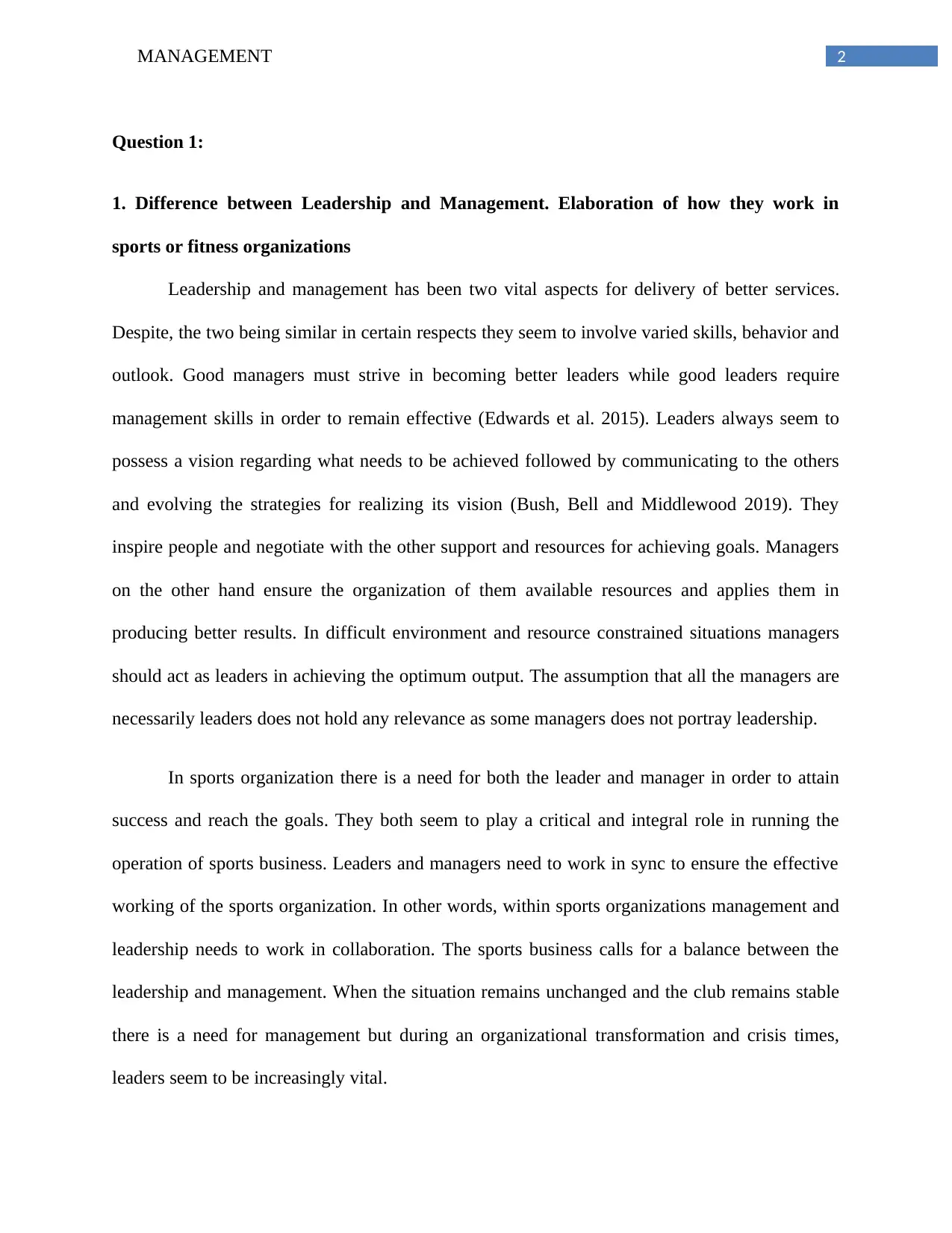
2MANAGEMENT
Question 1:
1. Difference between Leadership and Management. Elaboration of how they work in
sports or fitness organizations
Leadership and management has been two vital aspects for delivery of better services.
Despite, the two being similar in certain respects they seem to involve varied skills, behavior and
outlook. Good managers must strive in becoming better leaders while good leaders require
management skills in order to remain effective (Edwards et al. 2015). Leaders always seem to
possess a vision regarding what needs to be achieved followed by communicating to the others
and evolving the strategies for realizing its vision (Bush, Bell and Middlewood 2019). They
inspire people and negotiate with the other support and resources for achieving goals. Managers
on the other hand ensure the organization of them available resources and applies them in
producing better results. In difficult environment and resource constrained situations managers
should act as leaders in achieving the optimum output. The assumption that all the managers are
necessarily leaders does not hold any relevance as some managers does not portray leadership.
In sports organization there is a need for both the leader and manager in order to attain
success and reach the goals. They both seem to play a critical and integral role in running the
operation of sports business. Leaders and managers need to work in sync to ensure the effective
working of the sports organization. In other words, within sports organizations management and
leadership needs to work in collaboration. The sports business calls for a balance between the
leadership and management. When the situation remains unchanged and the club remains stable
there is a need for management but during an organizational transformation and crisis times,
leaders seem to be increasingly vital.
Question 1:
1. Difference between Leadership and Management. Elaboration of how they work in
sports or fitness organizations
Leadership and management has been two vital aspects for delivery of better services.
Despite, the two being similar in certain respects they seem to involve varied skills, behavior and
outlook. Good managers must strive in becoming better leaders while good leaders require
management skills in order to remain effective (Edwards et al. 2015). Leaders always seem to
possess a vision regarding what needs to be achieved followed by communicating to the others
and evolving the strategies for realizing its vision (Bush, Bell and Middlewood 2019). They
inspire people and negotiate with the other support and resources for achieving goals. Managers
on the other hand ensure the organization of them available resources and applies them in
producing better results. In difficult environment and resource constrained situations managers
should act as leaders in achieving the optimum output. The assumption that all the managers are
necessarily leaders does not hold any relevance as some managers does not portray leadership.
In sports organization there is a need for both the leader and manager in order to attain
success and reach the goals. They both seem to play a critical and integral role in running the
operation of sports business. Leaders and managers need to work in sync to ensure the effective
working of the sports organization. In other words, within sports organizations management and
leadership needs to work in collaboration. The sports business calls for a balance between the
leadership and management. When the situation remains unchanged and the club remains stable
there is a need for management but during an organizational transformation and crisis times,
leaders seem to be increasingly vital.
⊘ This is a preview!⊘
Do you want full access?
Subscribe today to unlock all pages.

Trusted by 1+ million students worldwide
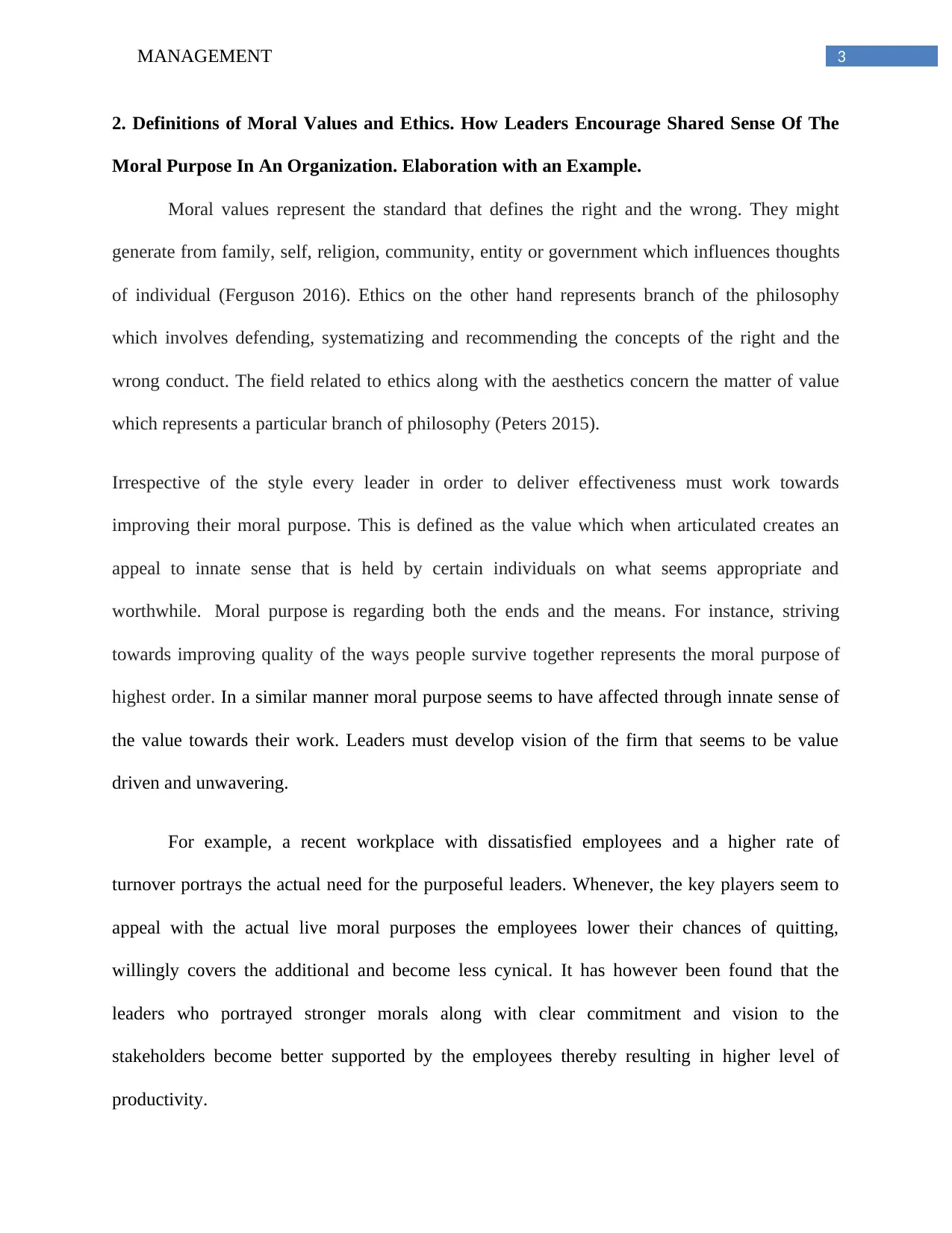
3MANAGEMENT
2. Definitions of Moral Values and Ethics. How Leaders Encourage Shared Sense Of The
Moral Purpose In An Organization. Elaboration with an Example.
Moral values represent the standard that defines the right and the wrong. They might
generate from family, self, religion, community, entity or government which influences thoughts
of individual (Ferguson 2016). Ethics on the other hand represents branch of the philosophy
which involves defending, systematizing and recommending the concepts of the right and the
wrong conduct. The field related to ethics along with the aesthetics concern the matter of value
which represents a particular branch of philosophy (Peters 2015).
Irrespective of the style every leader in order to deliver effectiveness must work towards
improving their moral purpose. This is defined as the value which when articulated creates an
appeal to innate sense that is held by certain individuals on what seems appropriate and
worthwhile. Moral purpose is regarding both the ends and the means. For instance, striving
towards improving quality of the ways people survive together represents the moral purpose of
highest order. In a similar manner moral purpose seems to have affected through innate sense of
the value towards their work. Leaders must develop vision of the firm that seems to be value
driven and unwavering.
For example, a recent workplace with dissatisfied employees and a higher rate of
turnover portrays the actual need for the purposeful leaders. Whenever, the key players seem to
appeal with the actual live moral purposes the employees lower their chances of quitting,
willingly covers the additional and become less cynical. It has however been found that the
leaders who portrayed stronger morals along with clear commitment and vision to the
stakeholders become better supported by the employees thereby resulting in higher level of
productivity.
2. Definitions of Moral Values and Ethics. How Leaders Encourage Shared Sense Of The
Moral Purpose In An Organization. Elaboration with an Example.
Moral values represent the standard that defines the right and the wrong. They might
generate from family, self, religion, community, entity or government which influences thoughts
of individual (Ferguson 2016). Ethics on the other hand represents branch of the philosophy
which involves defending, systematizing and recommending the concepts of the right and the
wrong conduct. The field related to ethics along with the aesthetics concern the matter of value
which represents a particular branch of philosophy (Peters 2015).
Irrespective of the style every leader in order to deliver effectiveness must work towards
improving their moral purpose. This is defined as the value which when articulated creates an
appeal to innate sense that is held by certain individuals on what seems appropriate and
worthwhile. Moral purpose is regarding both the ends and the means. For instance, striving
towards improving quality of the ways people survive together represents the moral purpose of
highest order. In a similar manner moral purpose seems to have affected through innate sense of
the value towards their work. Leaders must develop vision of the firm that seems to be value
driven and unwavering.
For example, a recent workplace with dissatisfied employees and a higher rate of
turnover portrays the actual need for the purposeful leaders. Whenever, the key players seem to
appeal with the actual live moral purposes the employees lower their chances of quitting,
willingly covers the additional and become less cynical. It has however been found that the
leaders who portrayed stronger morals along with clear commitment and vision to the
stakeholders become better supported by the employees thereby resulting in higher level of
productivity.
Paraphrase This Document
Need a fresh take? Get an instant paraphrase of this document with our AI Paraphraser
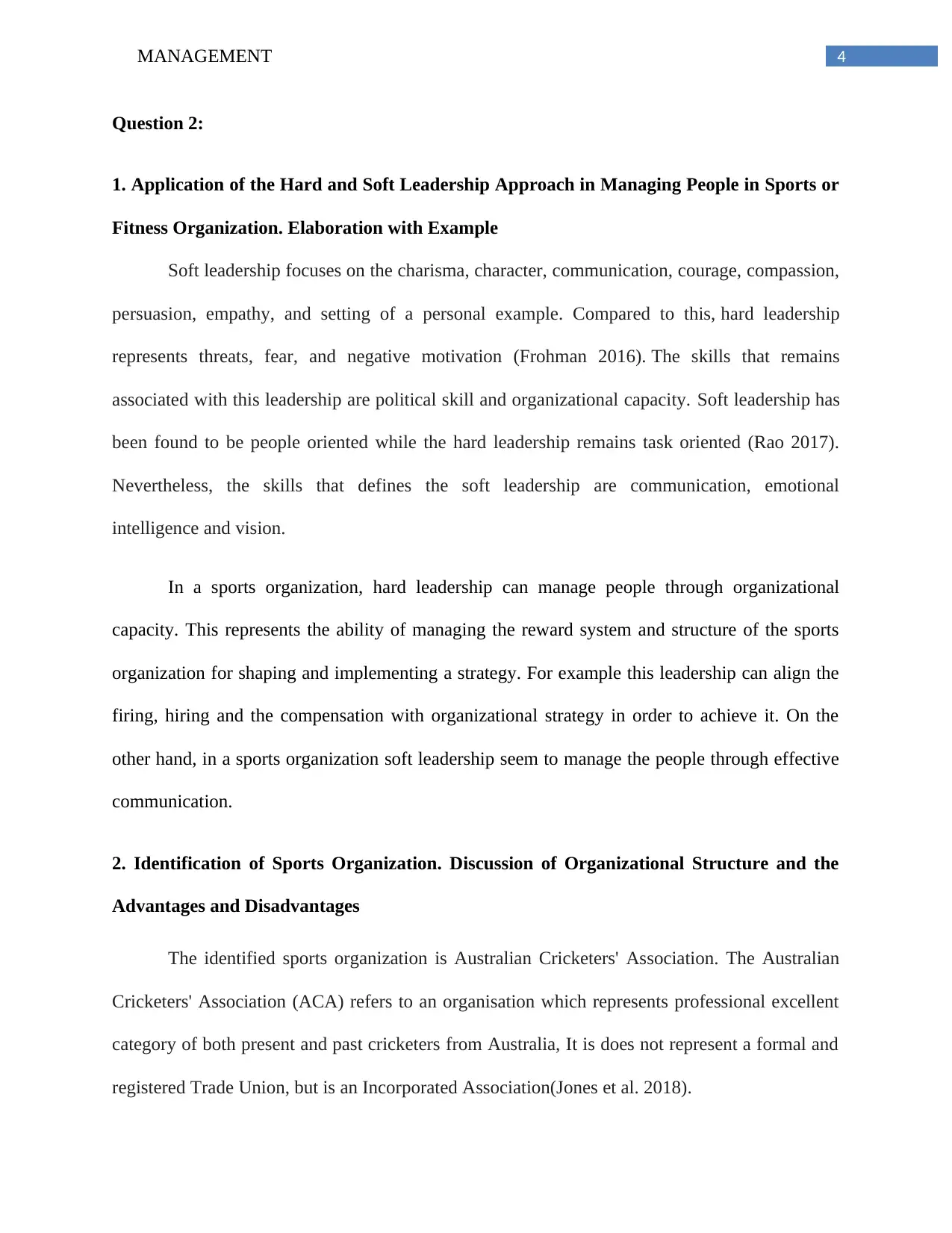
4MANAGEMENT
Question 2:
1. Application of the Hard and Soft Leadership Approach in Managing People in Sports or
Fitness Organization. Elaboration with Example
Soft leadership focuses on the charisma, character, communication, courage, compassion,
persuasion, empathy, and setting of a personal example. Compared to this, hard leadership
represents threats, fear, and negative motivation (Frohman 2016). The skills that remains
associated with this leadership are political skill and organizational capacity. Soft leadership has
been found to be people oriented while the hard leadership remains task oriented (Rao 2017).
Nevertheless, the skills that defines the soft leadership are communication, emotional
intelligence and vision.
In a sports organization, hard leadership can manage people through organizational
capacity. This represents the ability of managing the reward system and structure of the sports
organization for shaping and implementing a strategy. For example this leadership can align the
firing, hiring and the compensation with organizational strategy in order to achieve it. On the
other hand, in a sports organization soft leadership seem to manage the people through effective
communication.
2. Identification of Sports Organization. Discussion of Organizational Structure and the
Advantages and Disadvantages
The identified sports organization is Australian Cricketers' Association. The Australian
Cricketers' Association (ACA) refers to an organisation which represents professional excellent
category of both present and past cricketers from Australia, It is does not represent a formal and
registered Trade Union, but is an Incorporated Association(Jones et al. 2018).
Question 2:
1. Application of the Hard and Soft Leadership Approach in Managing People in Sports or
Fitness Organization. Elaboration with Example
Soft leadership focuses on the charisma, character, communication, courage, compassion,
persuasion, empathy, and setting of a personal example. Compared to this, hard leadership
represents threats, fear, and negative motivation (Frohman 2016). The skills that remains
associated with this leadership are political skill and organizational capacity. Soft leadership has
been found to be people oriented while the hard leadership remains task oriented (Rao 2017).
Nevertheless, the skills that defines the soft leadership are communication, emotional
intelligence and vision.
In a sports organization, hard leadership can manage people through organizational
capacity. This represents the ability of managing the reward system and structure of the sports
organization for shaping and implementing a strategy. For example this leadership can align the
firing, hiring and the compensation with organizational strategy in order to achieve it. On the
other hand, in a sports organization soft leadership seem to manage the people through effective
communication.
2. Identification of Sports Organization. Discussion of Organizational Structure and the
Advantages and Disadvantages
The identified sports organization is Australian Cricketers' Association. The Australian
Cricketers' Association (ACA) refers to an organisation which represents professional excellent
category of both present and past cricketers from Australia, It is does not represent a formal and
registered Trade Union, but is an Incorporated Association(Jones et al. 2018).
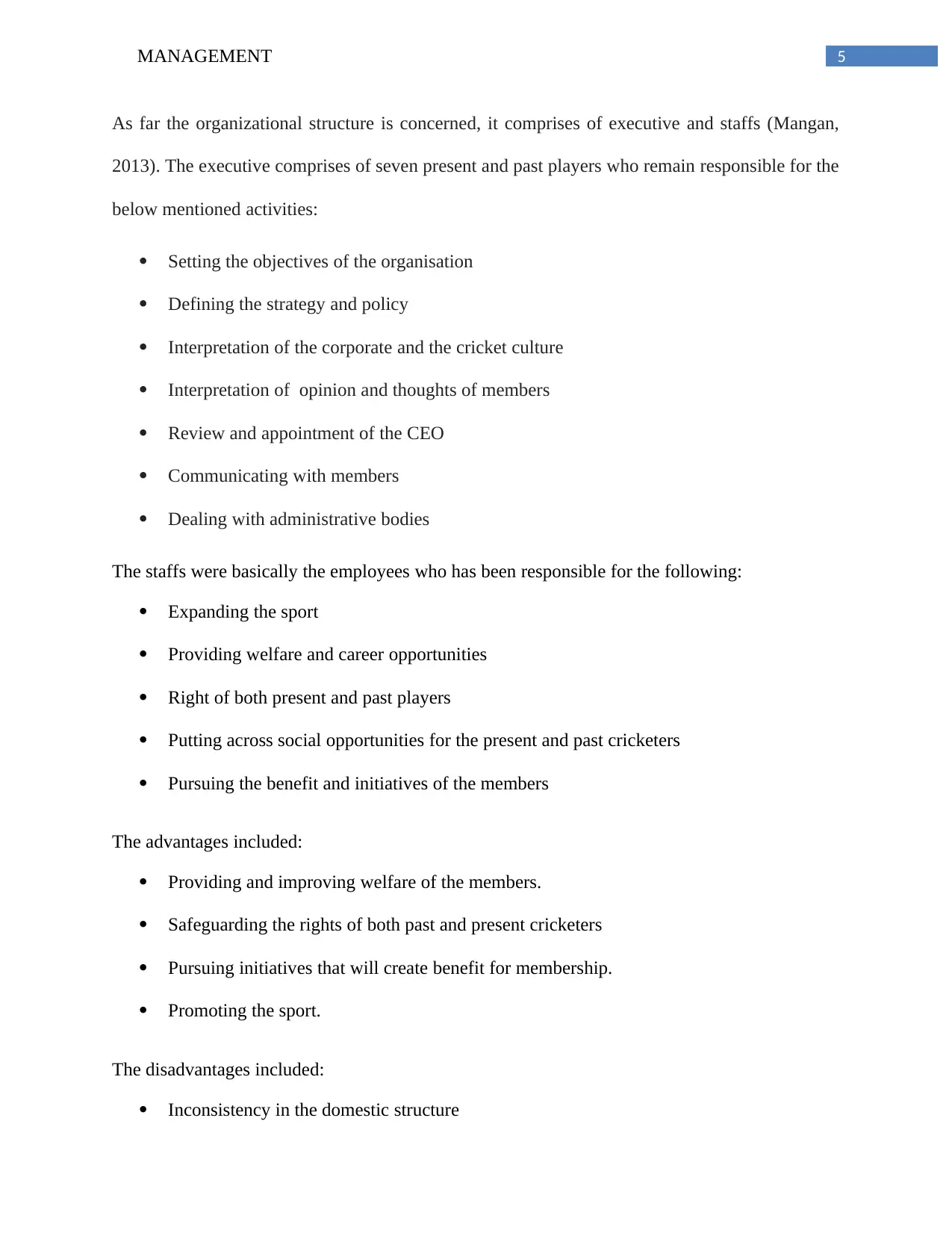
5MANAGEMENT
As far the organizational structure is concerned, it comprises of executive and staffs (Mangan,
2013). The executive comprises of seven present and past players who remain responsible for the
below mentioned activities:
Setting the objectives of the organisation
Defining the strategy and policy
Interpretation of the corporate and the cricket culture
Interpretation of opinion and thoughts of members
Review and appointment of the CEO
Communicating with members
Dealing with administrative bodies
The staffs were basically the employees who has been responsible for the following:
Expanding the sport
Providing welfare and career opportunities
Right of both present and past players
Putting across social opportunities for the present and past cricketers
Pursuing the benefit and initiatives of the members
The advantages included:
Providing and improving welfare of the members.
Safeguarding the rights of both past and present cricketers
Pursuing initiatives that will create benefit for membership.
Promoting the sport.
The disadvantages included:
Inconsistency in the domestic structure
As far the organizational structure is concerned, it comprises of executive and staffs (Mangan,
2013). The executive comprises of seven present and past players who remain responsible for the
below mentioned activities:
Setting the objectives of the organisation
Defining the strategy and policy
Interpretation of the corporate and the cricket culture
Interpretation of opinion and thoughts of members
Review and appointment of the CEO
Communicating with members
Dealing with administrative bodies
The staffs were basically the employees who has been responsible for the following:
Expanding the sport
Providing welfare and career opportunities
Right of both present and past players
Putting across social opportunities for the present and past cricketers
Pursuing the benefit and initiatives of the members
The advantages included:
Providing and improving welfare of the members.
Safeguarding the rights of both past and present cricketers
Pursuing initiatives that will create benefit for membership.
Promoting the sport.
The disadvantages included:
Inconsistency in the domestic structure
⊘ This is a preview!⊘
Do you want full access?
Subscribe today to unlock all pages.

Trusted by 1+ million students worldwide
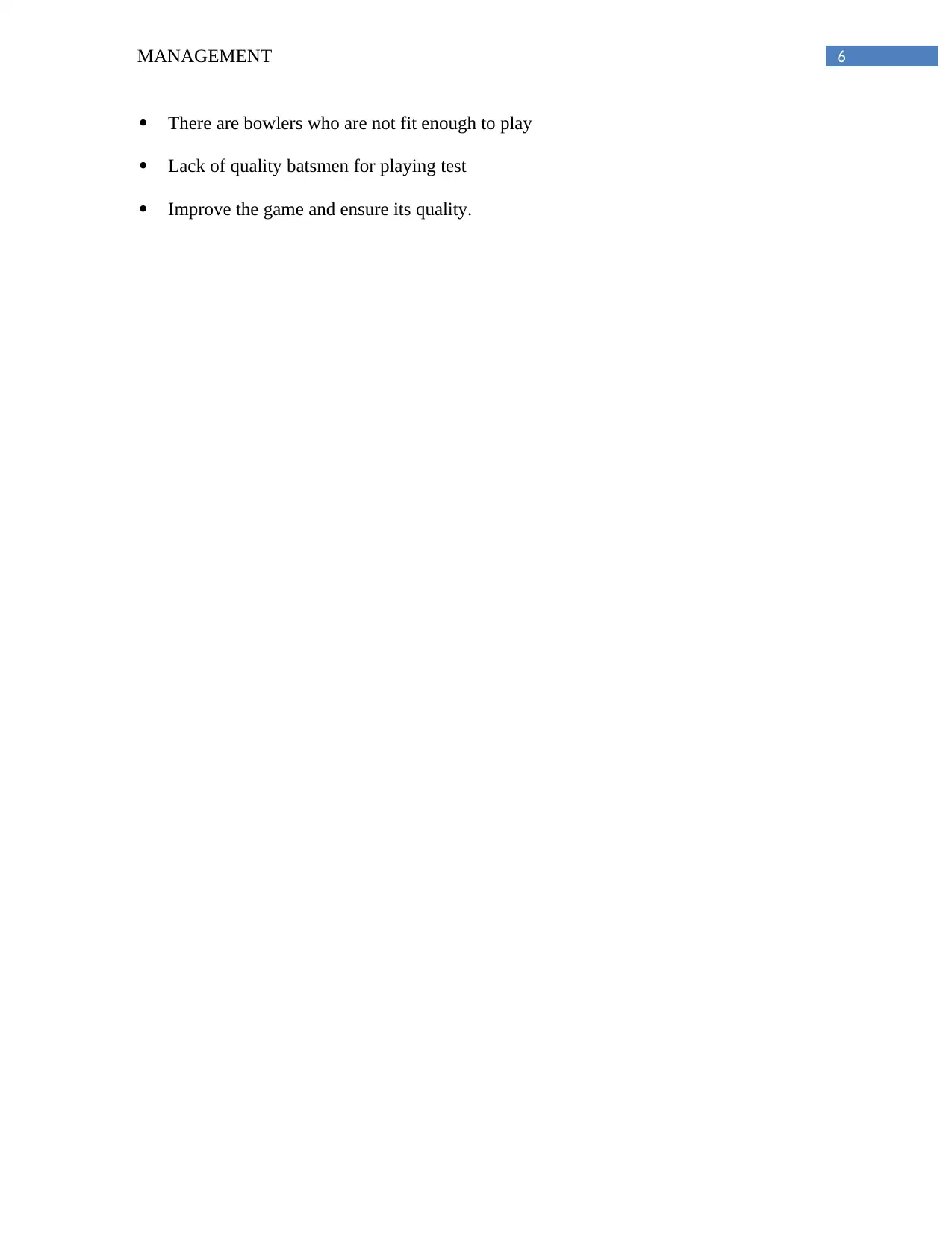
6MANAGEMENT
There are bowlers who are not fit enough to play
Lack of quality batsmen for playing test
Improve the game and ensure its quality.
There are bowlers who are not fit enough to play
Lack of quality batsmen for playing test
Improve the game and ensure its quality.
Paraphrase This Document
Need a fresh take? Get an instant paraphrase of this document with our AI Paraphraser
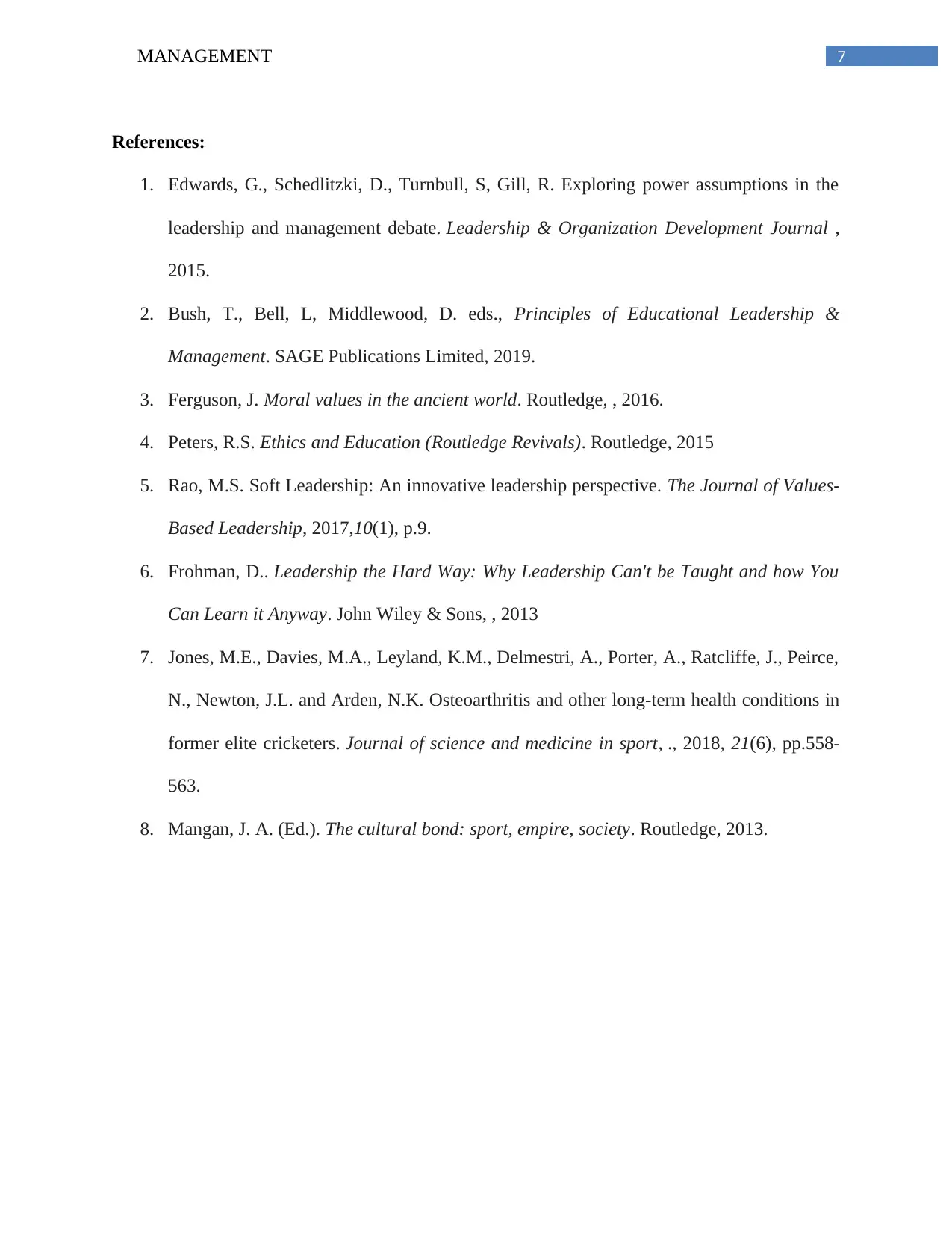
7MANAGEMENT
References:
1. Edwards, G., Schedlitzki, D., Turnbull, S, Gill, R. Exploring power assumptions in the
leadership and management debate. Leadership & Organization Development Journal ,
2015.
2. Bush, T., Bell, L, Middlewood, D. eds., Principles of Educational Leadership &
Management. SAGE Publications Limited, 2019.
3. Ferguson, J. Moral values in the ancient world. Routledge, , 2016.
4. Peters, R.S. Ethics and Education (Routledge Revivals). Routledge, 2015
5. Rao, M.S. Soft Leadership: An innovative leadership perspective. The Journal of Values-
Based Leadership, 2017,10(1), p.9.
6. Frohman, D.. Leadership the Hard Way: Why Leadership Can't be Taught and how You
Can Learn it Anyway. John Wiley & Sons, , 2013
7. Jones, M.E., Davies, M.A., Leyland, K.M., Delmestri, A., Porter, A., Ratcliffe, J., Peirce,
N., Newton, J.L. and Arden, N.K. Osteoarthritis and other long-term health conditions in
former elite cricketers. Journal of science and medicine in sport, ., 2018, 21(6), pp.558-
563.
8. Mangan, J. A. (Ed.). The cultural bond: sport, empire, society. Routledge, 2013.
References:
1. Edwards, G., Schedlitzki, D., Turnbull, S, Gill, R. Exploring power assumptions in the
leadership and management debate. Leadership & Organization Development Journal ,
2015.
2. Bush, T., Bell, L, Middlewood, D. eds., Principles of Educational Leadership &
Management. SAGE Publications Limited, 2019.
3. Ferguson, J. Moral values in the ancient world. Routledge, , 2016.
4. Peters, R.S. Ethics and Education (Routledge Revivals). Routledge, 2015
5. Rao, M.S. Soft Leadership: An innovative leadership perspective. The Journal of Values-
Based Leadership, 2017,10(1), p.9.
6. Frohman, D.. Leadership the Hard Way: Why Leadership Can't be Taught and how You
Can Learn it Anyway. John Wiley & Sons, , 2013
7. Jones, M.E., Davies, M.A., Leyland, K.M., Delmestri, A., Porter, A., Ratcliffe, J., Peirce,
N., Newton, J.L. and Arden, N.K. Osteoarthritis and other long-term health conditions in
former elite cricketers. Journal of science and medicine in sport, ., 2018, 21(6), pp.558-
563.
8. Mangan, J. A. (Ed.). The cultural bond: sport, empire, society. Routledge, 2013.
1 out of 8
Related Documents
Your All-in-One AI-Powered Toolkit for Academic Success.
+13062052269
info@desklib.com
Available 24*7 on WhatsApp / Email
![[object Object]](/_next/static/media/star-bottom.7253800d.svg)
Unlock your academic potential
Copyright © 2020–2025 A2Z Services. All Rights Reserved. Developed and managed by ZUCOL.





